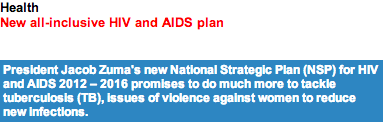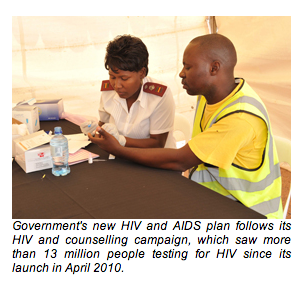
The strategic plan proposes to deal with HIV, sexually transmitted infections and tuberculosis by adopting an all-inclusive approach which includes preventative and therapeutic measures. 
President Zuma launched the plan on World Aids Day, December 1st at the Wolfson Stadium in KwaZakhele in the Eastern Cape.
Aims
The new strategy, which will be implemented from April, aims to:
- reduce new HIV infections by at least 50 per cent by using a combination of preventative measures
- start at least 80 per cent of patients on antiretroviral treatment with 70 per cent being alive and on treatment five years after they started
- reduce the number of new TB infections as well as deaths from TB by 50 per cent
- ensure an accessible legal framework that protects and promotes human rights in order to support the implementation of the strategic plan, and reduce stigma related to HIV and TB by at least 50 per cent.
The strategy will also address barriers that prevent the treatment of HIV, sexually transmitted diseases and TB and will increase the protection of human rights and improve access to justice.
Four zeros
President Zuma said the country had also adopted the “three zeros” agreed to at the United Nations high level meeting in New York this June as a vision for the next 20 years.
South Africa has added a fourth zero, which aims to eliminate HIV transmission from mother to child. The four zeros are:
- zero new HIV and TB infections
- zero new infections due to mother to child transmission
- zero preventable deaths associated with HIV and TB
- zero discrimination associated with HIV and TB.
President Zuma said government had learnt a lot from the previous plan and it now understood which methods worked and which did not.
Significant progress had been made in all areas of the previous plan. After launching the national HIV counselling and testing campaign in April 2010, more than 13 million people were tested for HIV and more than eight million were screened for TB.
Between January 2010 and September 2011, the number of public health facilities starting patients on antiretroviral treatment increased from 495 to 2 948 and the number of nurses
accredited to initiate and provide treatment had increased from 290 a few years ago to 10 542.
Violence against women
The President was pleased that the issue of violence against women was reflected in the new NSP. Recent research in South Africa showed that HIV infections in young women could be prevented if they were not subjected to violence or intimidation by their partners.
“Government is prioritising the fight against the abuse of women and children through law enforcement, as well as education and awareness. We must also enhance our socio-economic interventions to deal with poverty, unemployment, food insecurity and inequality... these either contribute to the spread of HIV or worsen impact of the epidemic,” said President Zuma.
Walk the talk
Welcoming the launch of the new plan, Prudence Mabela, who has been living with HIV for 22 years, said everyone had to walk the talk when it came to implementing the plan.
She urged other infected people to take treatment and those who have not tested to find out their status.
“You can trust the public hospitals, I’m using them and they are helping... With the treatment you can live longer. I’ve taken TB treatment for six months and it’s effective, including the ARVs,” said Mabela.
-Gabi Khumalo



 Facebook
Facebook Twitter
Twitter WhatsApp
WhatsApp